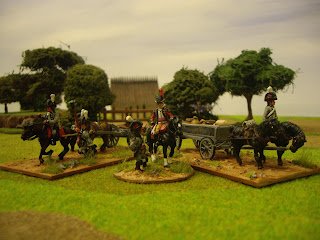More work on my various Salm-Kirberg units serving with the British Army during the 1790s. Have just completed a command base comprising an officer in the infantry battalion having a chat with another belonging to the horse artillery section. And I have also put together a supply waggon. Although officially civilians were hired to look after the baggage train I have long felt that some units may have allowed a few regulars to help manage this operation.
MGB
Wargame Rules, Ratios, etc
RAISING MINIATURE ARMIES FOR THE LATE 18TH CENTURY
I am very keen to keep my wargame rules as simple as possible, yet capture the character of the 1790s. Morale dominates the games as the opposing sides are very different. Most of the French troops are 'levee' battalions, which I have chosen to base in column as their ability to change formation on a battlefield must have been limited, nor do I believe their volley fire had any great value. Of better quality, able to change formation, will be white-coated regular and blue-coated volunteer battalions, aided by a fair number of skirmishers. The British, Austrian, Dutch and German armies are often outnumbered, but they maintain the discipline and order of typical 18th century armed forces. Interestingly, French revolutionary cavalry have little in common with their later Napoleonic counterparts, the former are few in number, often poorly mounted, and no match for those in the service of the Allies. All figures are 28mm in scale, using a 1=25 ratio.
Followers
Subscribe to:
Post Comments (Atom)



Superb, wonderful details!
ReplyDeletePhil, thanks for your encouragement,
DeleteMichael
Superb indeed Michael! I really enjoy looking at your Salm units. They are so obscure just where do you get your information on them?
ReplyDeleteVery best regards
CB
Some great information on the internet but so often I hark back to the Cecil Lawson volumes on The Uniforms of the British Army. I used to visit my local library to read these in the 1970s, since 1992 I have gained my own five volumes.
DeleteMichael